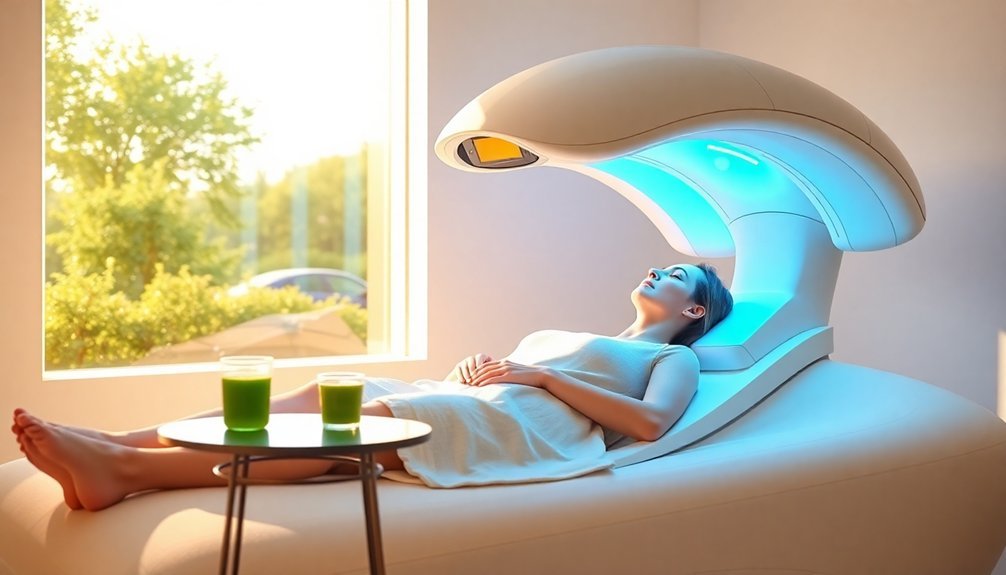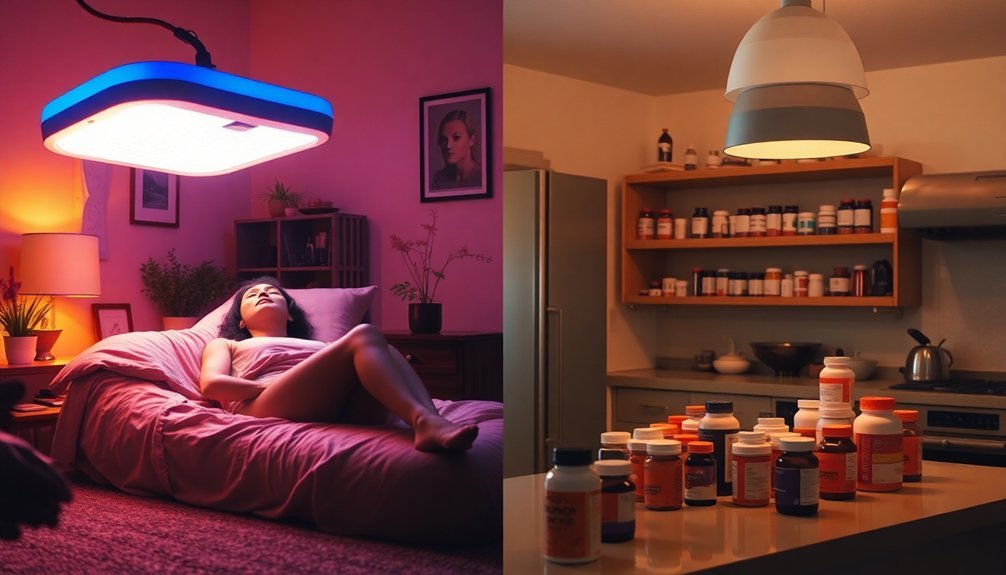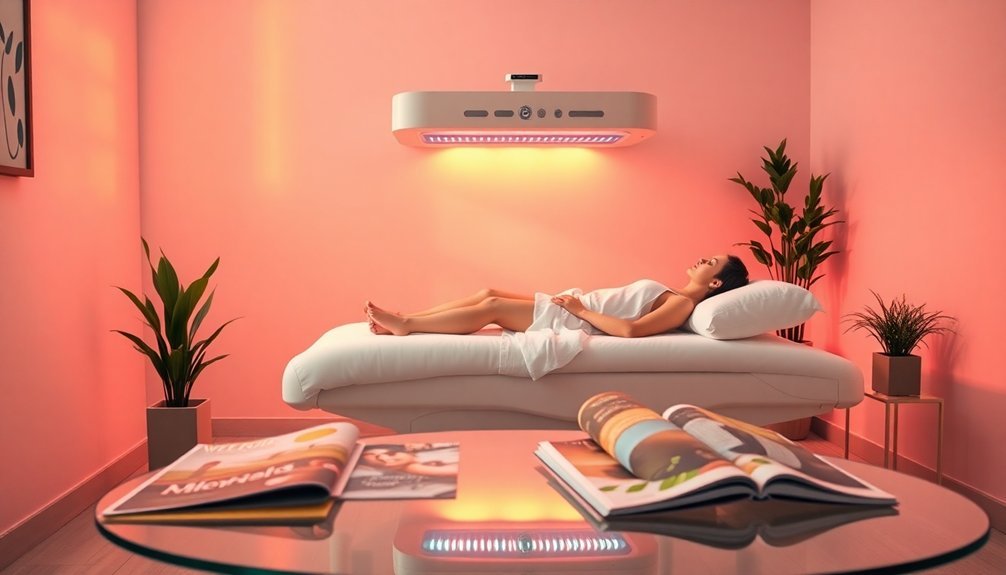Photobiomodulation (PBM) is a promising method for lowering cholesterol without medications. By using specific light wavelengths, PBM enhances your cellular metabolism and promotes cholesterol efflux, potentially reducing LDL levels. Clinical studies have shown that many individuals experience noticeable drops in serum cholesterol after treatment. PBM also supports better endothelial function, improving how your body handles lipids. Combining PBM with a heart-healthy diet and regular exercise can boost your results even further. If you're curious about the best protocols and how these therapies work, there's much more to explore on this innovative approach to cholesterol management.
Understanding Photobiomodulation

Understanding Photobiomodulation
When it comes to understanding photobiomodulation (PBM), it's vital to grasp what this innovative therapy entails. PBM, formerly known as Low Level Laser Therapy (LLLT), employs non-ionizing light sources like lasers and LEDs within the 400-1100 nm spectrum. This nonthermal approach activates endogenous chromophores, making it an appealing option for various medical applications.
The term PBM is now preferred by both researchers and practitioners, highlighting its credibility in the scientific community. You'll often see it referenced in discussions about healing and wellness because of its effectiveness in enhancing cellular functions. One of the key elements of PBM is that it triggers a biological cascade which increases cellular metabolism and promotes tissue regeneration.
The therapy's action is rooted in the interaction of photons with the cytochrome c complex in mitochondria, which stimulates the electron transport chain. This interaction boosts adenosine triphosphate (ATP) production, key for restoring normal cellular function.
Ultimately, PBM's benefits range from improving wound healing and relieving pain to reducing inflammation. By understanding how PBM works, you can appreciate its potential as a non-invasive treatment option, whether you're addressing acute or chronic conditions.
Mechanisms of Cholesterol Reduction
When you explore the mechanisms behind cholesterol reduction through photobiomodulation, you'll find that photon absorption plays a key role in influencing lipid metabolism. This interaction triggers various cellular responses that support cholesterol efflux and modulate lipid levels. Recent research indicates that PBMT promotes cholesterol efflux, further enhancing its potential impact on managing cholesterol levels. Understanding these processes can help you appreciate how light therapy might be a game changer for cholesterol management.
Photon Absorption Effects
Photon absorption plays an essential role in driving cellular processes that contribute to cholesterol reduction. When your cells absorb photons, they initiate various activities, impacting cholesterol metabolism directly.
For instance, low-energy laser irradiation can enhance nitric oxide (NO) production, which helps promote the health of blood vessels.
One significant effect of photobiomodulation therapy (PBMT) is the upregulation of ATP-binding cassette transporter A1 (ABCA1), which facilitates cholesterol efflux from macrophages. This process is essential for reducing cholesterol storage and improving lipid profiles.
Additionally, PBMT activates pathways, including the phosphatidylinositol 3-kinase/protein kinase C zeta/specificity protein pathway, further enhancing cholesterol transport out of cells.
What's really interesting is the biphasic dose-response profile often seen with photon exposure, indicating that tailored doses may optimize cholesterol reduction. According to recent studies, incorporating heart-healthy foods along with PBMT may synergistically enhance overall cholesterol management.
In clinical studies, participants commonly experienced reduced serum cholesterol levels, with many also seeing improvements in low-density lipoprotein (LDL) and triglyceride levels.
While there remains some variability in individual responses, the evidence suggests a promising role for photon absorption in promoting healthier cholesterol levels, laying the groundwork for further exploration of these mechanisms.
Lipid Metabolism Modulation
Lipid metabolism modulation plays an essential role in cholesterol reduction, particularly through mechanisms activated by photobiomodulation therapy (PBMT). When you undergo PBMT, it enhances cholesterol efflux in macrophages, primarily by upregulating the ATP-binding cassette transporter A1 (ABCA1). This means that as PBMT stimulates ABCA1, it helps clear cholesterol from foam cells, reducing your risk of atherosclerosis.
PBMT can also influence your lipid profiles. You may notice fluctuations in HDL and LDL levels, and some studies have even shown reduced triglyceride levels, particularly in animal models. However, the effects can vary based on sample types, suggesting that PBMT's mechanisms may differ in response to your individual biochemistry.
Moreover, PBMT improves endothelial function, which benefits lipid metabolism by enhancing blood circulation and lipid distribution. This improved circulation allows for better clearance of lipids from your bloodstream.
The therapy also increases ATP synthesis and generates mild oxidants that promote gene expression related to lipid metabolism, amplifying the overall effect on cholesterol levels. Ultimately, engaging in PBMT could lead to notable changes in your cholesterol and cardiovascular health.
Clinical Evidence and Findings

Recent research has demonstrated promising results regarding the effects of photobiomodulation therapy (PBMT) on cholesterol levels. In a study involving 20 volunteers, 75% experienced an overall reduction in cholesterol serum levels, with changes ranging from -1.0 to -31.0 mg/dL.
Significantly, 93% of participants who lowered their cholesterol also saw reductions in LDL levels, while 47% achieved this without impacting their HDL levels. Additionally, 60% of participants demonstrated decreased triglyceride levels.
The mechanisms behind these changes include PBMT's ability to promote cholesterol efflux from macrophages, thanks to the activation of the ATP-binding cassette transporter A1. PBMT also appears to increase high-density lipoprotein cholesterol and reduce plaque area when applied in atherosclerosis models.
However, it's essential to recognize that results can vary; some studies reported increased cholesterol levels post-treatment, particularly with different sample types.
This variability underscores the complexity of PBMT's effects on lipid profiles. Still, the overall findings suggest PBMT could offer a promising alternative to medication for managing cholesterol.
Further studies are needed to clarify these effects and establish consistent treatment protocols.
Treatment Parameters and Techniques
Various treatment parameters and techniques play an essential role in the effectiveness of photobiomodulation therapy (PBMT) for lowering cholesterol levels. When you consider PBMT, it's important to pay attention to the light sources, wavelengths, and application methods that can enhance your treatment.
- PBMT employs non-ionizing light sources like lasers and LEDs, with effective wavelengths ranging from 600nm to 1000nm.
- Specific wavelengths, like blue (435 nm) and red (629 nm) light, have distinct effects; for example, blue light inhibits cell growth more effectively at higher irradiance.
- Treatment frequency can vary, with protocols suggesting daily applications or up to twice a week, depending on your goals.
- You can apply PBMT directly to tissues or use innovative wearable devices, enhancing accessibility and convenience.
- The biological mechanisms involved facilitate increased ATP production and cholesterol mobilization, promoting healthier lipid profiles.
Understanding these parameters can help you tailor your PBMT experience and maximize its cholesterol-lowering potential. As you explore these techniques, remember that personalizing your approach is key to achieving the best results.
Comparison With Traditional Methods

When it comes to lowering cholesterol, dietary modifications and exercise play essential roles.
You might find that incorporating fiber-rich foods and regular physical activity can greatly impact your lipid levels.
However, PBMT offers a unique, non-dietary alternative that could be integrated with these traditional methods for enhanced results.
Dietary Modifications for Cholesterol
Making dietary modifications can greatly impact cholesterol levels, often offering a more effective approach than traditional methods like medication alone.
By focusing on your diet, you can manage your cholesterol more naturally and promote better heart health.
Here are some changes you can incorporate into your meals:
- Choose healthier fats: Limit saturated fats to less than 7% of your daily calorie intake and replace them with unsaturated oils like olive or canola.
- Limit cholesterol: Aim to consume less than 200 mg of cholesterol daily by reducing high-cholesterol foods, including liver and hard cheeses.
- Increase soluble fiber: Add whole grains, fruits, and legumes to your diet for at least 10-25 grams of fiber each day.
- Incorporate plant stanols and sterols: Look for foods fortified with these components, such as certain margarines and juices.
- Eat plenty of omega-3 rich foods: Consume fish, flaxseeds, and walnuts to help reduce LDL and triglyceride levels.
These dietary changes can give you the upper hand in controlling your cholesterol levels without solely relying on medications.
Exercise Benefits on Lipids
Engaging in regular exercise can lead to significant improvements in your lipid profile, often more effectively than relying solely on traditional methods such as medication.
Moderate-intensity exercise boosts HDL cholesterol by 6.6% and decreases LDL cholesterol by 7.2%. This exercise also enhances the function of HDL and increases cholesterol efflux by 13.5%.
Now, if you ramp up your intensity to high levels, you'll see HDL cholesterol increase by an additional 8.2%, with significant improvements occurring when your heart rate hits 75% of its maximum.
In comparison, while sauna bathing does yield a decrease in total and LDL cholesterol, it doesn't match the HDL cholesterol benefits provided by exercise.
Though both methods help improve lipid profiles, exercise wins out in enhancing overall cardiovascular health and body composition. Plus, exercise improves oxygen uptake, which sauna sessions don't directly address.
Ultimately, by making exercise a part of your routine, you're not just improving your cholesterol levels; you're also boosting your overall fitness and well-being, setting you up for a healthier future.
Integrating Multiple Approaches
Integrating multiple approaches to cholesterol management can enhance your overall effectiveness in lowering lipid levels.
While traditional medications like statins and PCSK9 inhibitors have their place, Photobiomodulation Therapy (PBMT) provides a compelling non-invasive alternative. This therapy promotes cholesterol efflux from macrophages and may help improve your lipid profiles without the side effects often associated with standard medications.
Consider the following strategies to integrate PBMT with your cholesterol management plan:
- Combine with lifestyle changes: Incorporate a heart-healthy diet alongside PBMT to maximize cholesterol reduction.
- Stay active: Engage in regular physical activity to improve HDL levels and support overall heart health.
- Manage stress: Practice mindfulness or relaxation techniques as stress can negatively impact cholesterol levels.
- Sleep well: Prioritize adequate sleep to support metabolic processes related to cholesterol management.
- Explore natural supplements: Discuss with your healthcare provider the potential benefits of natural supplements for added support.
Future Directions in Research
As researchers look ahead, the exploration of photobiomodulation therapy (PBMT) for lowering cholesterol will benefit from a more structured approach. Future studies need to emphasize randomized placebo-controlled trials to establish the long-term effects of PBMT on lipid profiles.
While initial findings show promise, variability in results suggests the need for larger sample sizes and consistent methodologies. Investigating the mechanisms of PBMT is essential, particularly how it promotes cholesterol efflux from macrophages and activates ATP-binding cassette transporter A1.
Understanding these biological effects and the involved signaling pathways will clarify the treatment's efficacy. Moreover, integrating PBMT with lifestyle changes, like diet and exercise, could enhance its cholesterol-lowering potential.
Researchers should also focus on developing clinical guidelines to identify suitable patients for this non-invasive approach, considering individual risk factors for heart disease. Regular monitoring of cholesterol and health metrics will help evaluate PBMT's effectiveness over time.
Lastly, comparative studies with previous findings will strengthen the validity of PBMT's impact, ensuring a clearer roadmap for future applications. By approaching PBMT research systematically, you'll pave the way for innovative treatments that may revolutionize cholesterol management.
Frequently Asked Questions
Is Photobiomodulation Safe for All Individuals?
Photobiomodulation isn't safe for everyone. If you've got a history of skin cancer or eye issues, it's best to consult your doctor. Also, protect your eyes and skin from potential harm during treatment.
How Soon Can I Expect Results From Treatment?
You may notice some changes shortly after treatment, but results can vary widely among individuals. It's essential to manage expectations since consistent outcomes often depend on your specific circumstances and the treatment approach used.
Are There Any Side Effects of Photobiomodulation?
You won't encounter significant side effects from photobiomodulation when used correctly. However, high-intensity red LED lights can cause skin issues, and eye protection is essential to prevent potential damage. Always consult your doctor if unsure.
Can Photobiomodulation Be Combined With Other Therapies?
Yes, you can combine photobiomodulation with various therapies. Integrating it with dietary changes, pharmacological treatments, or physical therapy can enhance overall effectiveness, promoting better outcomes in health management and tissue regeneration.
What Should I Do if My Cholesterol Levels Don't Improve?
If your cholesterol levels don't improve, consider changing your lifestyle further—exercise more, adjust your diet, quit smoking, and reduce alcohol. Also, consult your healthcare provider about medication options for additional support.
In Summary
Incorporating photobiomodulation into your wellness routine could help you manage cholesterol levels without relying on medications. By harnessing light to influence biological processes, this innovative approach offers a promising alternative to traditional treatments. As research continues to explore its efficacy and potential applications, you have an opportunity to embrace this non-invasive technique for better health. Staying informed about these developments can empower you to take control of your cholesterol and overall well-being.





Leave a Reply